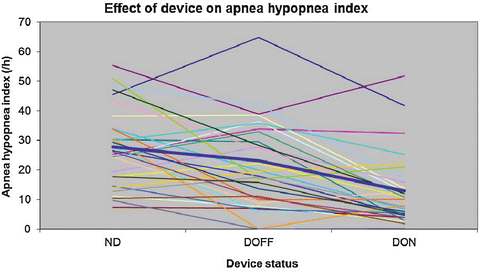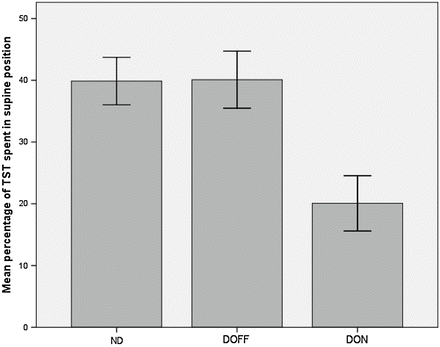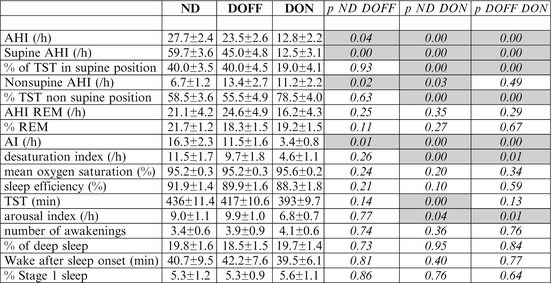Fig. 1
(a, b) The middle part (ring structure) of the apparatus shown consists of a small vibrating motor (like the one used in cell phones) and a position sensor. Three small round batteries (two positioned on the left, one on the right) are connected via the white cables. The braided black cables connect the device to the polysomnograph system
Results
During a study period of 18 months, 30 patients were included. In these patients the third PSG was performed 1 week to 3 months, median 1.5 months, after the first PSG (Table 1). Individual body mass indices over time did not differ more than 0.2 kg/m2. Polysomnography results were divided into three groups: no device (ND), device attached in OFF modus (DOFF) and device attached in ON modus (DON). Display of p-values will be as follows: between ND and DOFF, between ND and DON and between DOFF and DON.
Table 1
Baseline characteristics of all patients (n = 30)
Patient characteristics | |
|---|---|
Age (years) | 48.0 ± 9.5 |
Body mass index (kg/m2) | 27.7 ± 3.6 |
Male:female ratio | 6:1 |
Median months from PSG 1–3 | 1.5 |
Analysis of polysomnography data showed that the device worked well in 27 patients. All patients slept at least some time of each (ND, DOFF, DON) of the three nights in a supine position. In three patients the device did not work properly. According to the position sensor in these patients, despite an episode of supine position, the device did not vibrate. The analysis was performed on intention-to-treat basis, and therefore, these patients were not excluded from analysis. No side effects were reported.
The effect of the device on mean sleep parameters ± standard error of the mean is shown in Fig. 4. Highlighted values indicate significance.
In Fig. 2 the effect of the device on apnea–hypopnoea index for each individual patient is shown. The thicker line shows the mean value for all patients. Although wearing the device in OFF modus already had a significant effect on the AHI, the decrease in AHI was much larger when the device was worn in ON modus. Differences in AHI between ND and DOFF and between DOFF and DON were not affected by sleeping the first or the second night with the device attached in ON modus (data not shown here).


Fig. 2
The thickened line depicts the mean value. ND no device, DOFF device attached in OFF modus, DON device attached in ON modus
The average percentage of total sleep time spent in supine position significantly decreased from 40.0 (ND) and 40.0 (DOFF) to 19.0 % (DON) when the device was worn in ON modus (p = 0.93, 0.00, 0.00) (Fig. 3). Individuals who wore the device in ON modus the first night did not seem to avoid the supine position more effectively the second night (without vibration) compared to those who wore the device off in the first night (data not shown). This could be due to the time (1–2 weeks) in between the two recordings.


Fig. 3
Effect of device on percentage of TST in supine position. TST total sleep time, ND no device, DOFF device attached in OFF modus, DON device attached in ON modus. The y error bars depict the standard error of the mean
The device attached in OFF modus did not have a significant effect on the desaturation index when compared to no device. The device in ON modus did have a significant effect on the desaturation index when compared to no device and in OFF modus (Fig. 4).


Fig. 4
Effect of device on mean sleep parameters. AHI apnea-hypopnoea index, AI apnea index, TST total sleep time, ND no device, DOFF device attached in OFF modus, DON device attached in ON modus. Shaded are p-values <0.05. Standard error of the means is shown
Mean total sleep times were 436 (ND), 417 (DOFF) and 393 (DON) minutes (p = 0.14, 0.00, 0.13), showing that the device in ON modus leads to a significant reduction in total sleep time when compared to no device attached.
Arousal index was found to be 9.0 (ND), 9.9 (DOFF) and 6.8 (DON) (p = 0.77, 0.04, 0.01). The arousal index was significantly lower in the group with the device in ON modus when compared to the no device group and the group with the device in OFF modus.
The effect of the device and its status on mean oxygen saturation, sleep efficiency, percentage of deep sleep and number of awakenings was insignificant. Sleep efficiency was found to be 91.9 % (ND), 89.9 % (DOFF) and 88.3 % (DON) (p = 0.21, 0.10, 0.59); percentage of deep sleep was 19.8 (ND), 18.5 (DOFF) and 19.7 (DON) (p = 0.73, 0.95, 0.84). Mean number of awakenings was 3.4 (ND), 3.9 (DOFF) and 4.1 (DON) (p = 0.74, 0.36, 0.76).
Stay updated, free articles. Join our Telegram channel

Full access? Get Clinical Tree






